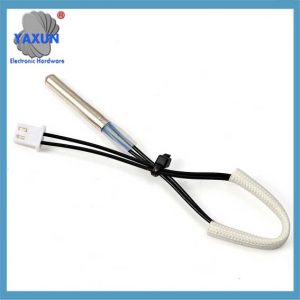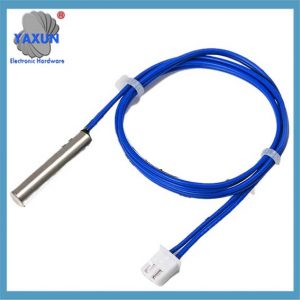Control indoor ambient temperature;
Condenser tube temperature;
The temperature sensor for air conditioner is negative temperature coefficient thermistor, NTC genoemd. Its resistance decreases with increasing temperature and increases with decreasing temperature. The resistance at 25℃ is nominal value. Common faults of NTC include resistance increase, open circuit, resistance change due to moisture and mildew, short circuit, poor contact between plug and socket or leakage, enz. Abnormal voltage at the detection terminal of air conditioner CPU causes air conditioner failure.
Commonly used NTC thermistors for air conditioner
There are three types: indoor ambient temperature NTC, indoor coil NTC, and outdoor coil NTC. Higher-end air conditioners also use external ambient temperature NTC, compressor suction and exhaust NTC, enz.
NTC has two main uses in the circuit as shown in Figure 1: Temperature changes cause NTC resistance to change, and the voltage at the CPU terminal also changes accordingly. The CPU determines the working state of the air conditioner based on the change in voltage.
Function of air conditioner temperature sensor
I. Indoor ambient temperature sensor:
(1) Used to automatically control indoor temperature during heating or cooling.
(2) Heating is used to control the operation of the auxiliary electric heater.
2. Indoor coil temperature sensor:
(1) Used to prevent cold wind control during winter heating.
(2) Used to prevent freezing protection during summer cooling.
(3) Used to control the wind speed of the indoor unit.
(4) Cooperate with the chip to realize fault self-protection.
(5) Control the frost of the outdoor unit during heating.
3. Outdoor ambient temperature sensor:
(1) The system automatically protects when the outdoor temperature is too high or too low.
(2) Used for outdoor unit wind speed during cooling or heating.
4. Outdoor coil temperature sensor:
(1) Used for outdoor unit dehumidification during heating.
(2) Used for overheating protection or anti-freezing protection during cooling or heating.
5. Outdoor unit compressor exhaust temperature sensor:
(1) The system automatically protects when the compressor exhaust temperature is too high.
(2) Used to control the opening degree of the electronic expansion valve and the increase or decrease of the compressor frequency in variable frequency air conditioners. Function of indoor ambient temperature NTC:
Indoor ambient temperature NTC detects the temperature of the indoor environment and automatically starts, stops or changes frequency according to the set working state. Fixed frequency air conditioner makes the indoor temperature difference range to the set value + 1℃, dat is, if the cooling is set to 24℃, the compressor will stop when the temperature drops to 23℃, and the compressor will work when the temperature rises to 25℃. If the heating is set to 24℃, the compressor will stop when the temperature rises to 25℃, and the compressor will work when the temperature falls back to 23℃.
It is worth noting that the temperature setting range is generally between 15℃-30℃, so cooling does not work at an ambient temperature below 15℃, and heating does not work at an ambient temperature above 30℃.
 English
English العربية
العربية Български
Български 粤语
粤语 中文(简体)
中文(简体) 中文(漢字)
中文(漢字) Nederlands
Nederlands Suomi
Suomi Français
Français Deutsch
Deutsch Ελληνικά
Ελληνικά Magyar
Magyar Italiano
Italiano 日本語
日本語 한국어
한국어 Polski
Polski Português
Português Română
Română Русский
Русский Slovenščina
Slovenščina Español
Español Svenska
Svenska ภาษาไทย
ภาษาไทย Türkçe
Türkçe Tiếng Việt
Tiếng Việt



